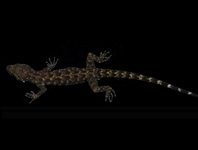Abstract
Osteological characters supporting monophyly and identification of extant Leiognathidae are reviewed. Ten osteological synapomorphies support monophyly of the Leiognathidae, involving modification of the ribs, gill arches, palatoquadrate, median fins and branchiostegals. Fourteen additional characters are noted that nest the Leiognathidae within the Acanthuriformes (sensu Gill & Leis). Nine further characters are noted as useful for identification of leiognathids, though each occurs more widely among acanthuriforms and other fishes. Three fossil genera that have been assigned to the Leiognathidae are briefly reviewed for the various leiognathid characters. Only one fossil genus, †Euleiognathus Yabumoto & Uyeno, appears correctly placed in the family.
References
Agassiz, L. (1838) Recherches sur les poisons fossiles. Tome IV. Petitpierre, Neuchtel, pp. 16*.
Baldwin, Z.H. & Sparks, J.S. (2011) A new species of Secutor (Teleostei: Leiognathidae) from the Western Indian Ocean. Zootaxa, 2998 (1), 39–47.
https://doi.org/10.11646/zootaxa.2998.1.3
Bannikov, A.F. (2001) A new genus of ponyfish (Perciformes, Leiognathidae). Journal of Ichthyology, 41, 112–114.
Bannikov, A.F. (2014) The new genus Eoleiognathus for the percoid fish Pygaeus dorsalis Agassiz from the Eocene of Bolca in northern Italy, a putative ponyfish (Perciformes, Leoignathidae). Studi e Richerche sui Giacimenti terziari di Bolca, 15, 35–42.
Bloch, M.E. (1787) Naturgeschichte der ausländischen Fische. Vol. 3. Auf Kosten des Verfassers und in Commission bei dem Buchhändler Hr. Hesse, Berlin, xii + 146 pp., pls. 181–216.
Bloch, M.E. (1795) Naturgeschichte der ausländischen Fische. Vol. 9. Auf Kosten des Verfassers und in Commission bei dem Buchhändler Hr. Hesse, Berlin, ii + 192 pp., pls. 397–429.
Daniltschenko, P.G. (1980) Order Perciformes. Trudy Paleontologicheskogo instituta Acadamii Nauk SSSR, 178, 115–121 + 125–169.
Ferry‐Graham, L.A., Wainwright, P.C., Hulsey, C.D. & Bellwood, D.R. (2001) Evolution and mechanics of long jaws in butterflyfishes (family Chaetodontidae). Journal of Morphology, 248, 120–143.
https://doi.org/10.1002/jmor.1024
Fujita, K. (1990) The Caudal Skeleton of Teleostean Fishes. Tokai University Press, Tokyo, 897 pp.
Gill, A.C. & Leis, J.M. (2019) Phylogenetic position of the fish genera Lobotes, Datnioides and Hapalogenys, with a reappraisal of acanthuriform composition and relationships based on adult and larval morphology. Zootaxa, 4680 (1), 1–81.
https://doi.org/10.11646/zootaxa.4680.1.1
Günther, A. (1874) Descriptions of new species of fishes in the British Museum. Annals and Magazine of Natural History, Series 4, 14, 368–371.
https://doi.org/10.1080/00222937408680987
Heads, M. (2012) Bayesian transmogrification of clade divergence times: A critique. Journal of Biogeography, 39, 1749–1756.
https://doi.org/10.1111/j.1365-2699.2012.02784.x
Hess, H., & Weiler, W. (1955) Untersuchungen an Fischen aus dem Alttertiär der Umgebung von Basel. Eclogae Geologicae Helvetiae, 48, 427–447.
Hilton, E.J. & Bemis, W.E. (2005) Grouped tooth replacement in the oral jaws of the tripletail, Lobotes surinamensis (Perciformes: Lobotidae), with a discussion of its proposed relationship to Datnioides. Copeia, 2005, 665–672.
https://doi.org/10.1643/CI-04-328R
James, P.S.B.R. (1985) Comparative osteology of the fishes of the family Leiognathidae. Part I. Osteology. Indian Journal of Fisheries, 32, 309–358.
Kimura, S., Yamashita, T. & Iwatsuki, Y. (2000) A new species, Gazza rhombea, from the Indo-West Pacific, with a redescription of G. achlamys Jordan & Starks, 1917 (Perciformes: Leiognathidae). Ichthyological Research, 47, 1–12.
https://doi.org/10.1007/BF02674308
Lacepède, B.G.E. (1801) Histoire naturelle des poisons. Vol. 3. Chez F. G. Levrault, Paris, lxvi + 558 pp., 34 pls.
Micklich, N., Bannikov, A.F. & Yabumoto, Y. (2017) First record of ponyfishes (Perciformes: Leiognathidae) from the Oligocene of the Grube Unterfeld (‘‘Frauenweiler’’) clay pit. Paläontologische Zeitschrift, 91, 375–398.
https://doi.org/10.1007/s12542-017-0340-1
Nelson, G.J. (1969) Origin and diversification of teleostean fishes. Annals of New York Academy of Sciences, 167, 18–30.
https://doi.org/10.1111/j.1749-6632.1969.tb20431.x
Nelson, G. & Ladiges, P.Y. (2009) Biogeography and the molecular dating game: A futile revival of phenetics? Bulletin de la Socié té Gé ologique de France, 180, 39–43.
https://doi.org/10.2113/gssgfbull.180.1.39
Niebuhr, C. (1775) Descriptiones animalium avium, amphibiorum, piscium, insectorum, vermium; quae in itinere orientali observavit Petrus Forskål. Post mortem auctoris edidit Carsten Niebuhr, Hauniae, 20 + xxxiv pp., 164 maps.
Ogilby, J.D. (1912) On some Queensland fishes. Memoirs of the Queensland Museum, 1, 26–65, pls. 12–14.
Rosen, D.E. & Patterson, C. (1990) On Müller’s and Cuvier’s concepts of pharyngognath and labyrinth fishes and the classification of percomorph fishes, with an atlas of percomorph dorsal gill arches. American Museum Novitates, 2983, 1–57.
Siegel, J. (1982) Median fin-spine locking in the ponyfishes (Perciformes: Leiognathidae). Copeia, 1982, 202–205.
https://doi.org/10.2307/1444296
Sparks, J.S. & Chakrabarty, P. (2015) Description of a new genus of ponyfishes (Teleostei: Leiognathidae), with a review of the current generic-level composition of the family. Zootaxa, 3947 (2), 181–190.
https://doi.org/10.11646/zootaxa.3947.2.2
Sparks, J.S. & Dunlap, P.V. (2004) A clade of non-sexually dimorphic ponyfishes (Teleostei: Perciformes: Leiognathidae): phylogeny, taxonomy, and description of a new species. American Museum Novitates, 3459, 1–21.
https://doi.org/10.1206/0003-0082(2004)459%3C0001:ACONDP%3E2.0.CO;2
Springer, V.G. & Johnson, G.D. (2004) Study of the dorsal gill-arch musculature of teleostome fishes, with special reference to the Actinopterygii. Bulletin of the Biological Society of Washington, 11, 1–260, 205 pls.
https://doi.org/10.5962/bhl.title.49077
Starks, E.C. (1911) The osteology and relationships of Leiognathus, a genus of scombroid fishes. Leland Stanford Junior University Publications, University Series, 5, 5–15.
Taylor, W.R. & van Dyke, G.C. (1985) Revised procedures for staining and clearing small fishes and other vertebrates for bone and cartilage study. Cybium, 9, 107–119.
Tyler, J.C., Johnson, G.D., Nakamura, I. & Collette, B.B. (1989) Morphology of Luvarus imperialis (Luvaridae), with a phylogenetic analysis of the Acanthuroidei (Pisces). Smithsonian Contributions to Zoology, 485, 1–78.
https://doi.org/10.5479/si.00810282.485
Williams, D.M. & Ebach, M.C. (2008) Foundations of Systematics and Biogeography. Springer Science + Business Media, New York, 309 pp.
https://doi.org/10.1007/978-0-387-72730-1
Yabumoto, Y. & Uyeno, T. (1994) A new Miocene ponyfish of the genus Leiognathus (Pisces, Leiognathidae) from Tottori Prefecture, Japan. Bulletin of the National Science Museum Tokyo, C, 20, 66–77.
Yabumoto, Y. & Uyeno, T. (2011) Euleiognathus, a new genus proposed for the Miocene ponyfish, Leiognathus tottori Yabumoto and Uyeno 1994 (Perciformes: Leiognathidae) from Japan. Ichthyological Research, 58, 19–23.
https://doi.org/10.1007/s10228-010-0182-2
Zaragüeta Bagils, R., Ung, V., Grand, A., Vignes-Lebbe, R., Cao, N. & Ducasse, J. (2012) LisBeth: New cladistics for phylogenetics and biogeography. Comptes Rendus Palevol, 11, 563–566.
https://doi.org/10.1016/j.crpv.2012.07.002
Zehren, S.J. (1987) Osteology and evolutionary relationships of the boarfish genus Antigonia (Teleostei: Caproidae). Copeia, 1987, 564–592.
https://doi.org/10.2307/1445651

